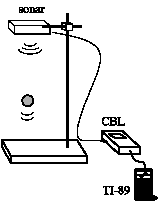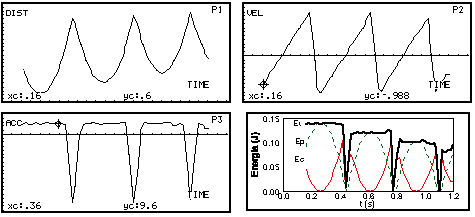

An ultrasonic motion detector (CBR), acting as a sonar, measures the distance of a sound-reflecting object by recording the time delay t of the echo. The distance is computed as the product x = t v, where v is the sound speed in air.
At each sampling time also the velocity and the acceleration of the target body are calculated and recorded.
A ping-pong ball is left in free fall below the CBR (face-down); therefore the x-axis is vertical and directed downward, and the "restoring" force (gravity) is constant and positive.
The quasi-elastic properties
of the ball and of the ground provide large negative acceleration pulses
at each bounce.

The plots x(t), v(t), a(t) vs. time give a complete description of the motion: x(t) is made of a series of parabolas, v(t) is made of a series of straight segments, a(t) is a constant (positive) value with large (negative) peaks corresponding to collisions with the ground.
By fitting v(t), within a single segment, a value of the acceleration can be obtained that is slightly less than 9.81 m/s2.
Distance values x(t) may be transformed into height values h(t)=xo—x(t), upward measured from the origin at distance xo. In this reference frame it is easier to calculate the gravitational energy U=mgh and the kinetic energy Ec=(1/2)mv2.
The total energy (E=U+Ec) behavior may be studied in a plot vs. time: it clearly shows that energy is lost mainly during collisions, indicating some details of the collision process. The kinetic energy is temporary transformed into elastic energy (not detected by sonar), and only partially given back at the end of the collision.
Period T measurements for various rebounces show that oscillation is anharmonic. A plot of T versus sqrt(Xmax), fitted by a straight line, may be understood within the simple model of uniformly accelerated motion, where 4sqrt(2/a) is the value of the predicted slope.